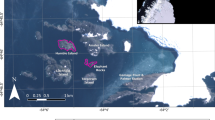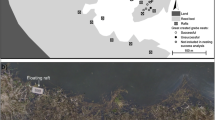Abstract
Habitat selection involves a series of decisions that are arguably the most important decisions that animals make and these decisions occur at multiple hierarchical spatial scales. Colonial-nesting birds face a unique challenge when selecting a nest site because each bird’s choices are severely constrained by other birds within their breeding colony. Individuals must seek out optimum nesting locations within the constraint of the colony’s geographic location. We investigated how water depth and proximity to open water affected 4th-order nest-site selection of Western and Clark’s Grebes (Aechmophorus occidentalis, Aechmophorus clarkii), colonial nesting waterbirds that have declined in abundance across their range. We used an orthomosiac that we created from ~ 500 aerial drone images of a large breeding colony to construct a Resource Selection Function to describe microhabitat features that influence nest-site placement within the colony footprint. Grebes preferred to nest in portions of the colony with intermediate water depths (40-80 cm during nest construction) and they preferred to nest in portions of the colony furthest from open water. Understanding how individual birds make use of available microhabitat features within the footprint of their breeding colony can help inform conservation efforts of colonial-nesting birds, particularly for species that nest in wetland habitats whose water levels are managed for human use.




Similar content being viewed by others
Data Availability
The datasets generated and/or analyzed during the current study are not owned by U.S. Geological Survey and they are available upon request from the authors.
References
Aebisher NJ, Coulson C (1990) Survival of the kittiwake in relation to sex, year, breeding experience, and position in the colony. J Anim Ecol 59:1063–1071
AgiSoft PhotoScan Professional (2018) Version 1.2.6. Retrieved from http://www.agisoft.com/downloads/installer/
Allen JH, Nuechterlein GL, Buitron D (2008) Weathering the storm: How wind and waves impact Western Grebe nest placement and success. Waterbirds 31:402–410
Boyce MS, Vernier PR, Nielsen SE, Schmiegelow FKA (2002) Evaluating resource selection functions. Ecol Model 157:281–300
Burnham KP, Anderson DR (2002) Model selection and multimodel inference: a practical information-theoretic approach, second edition. Springer-Verlag, New York
Donovan TM, Thompson FR III (2001) Modeling the ecological trap hypothesis: a habitat and demographic analysis for migrant songbirds. Ecol Appl 11:871–882
Erickson ME, Found-Jackson C, Boyce MS (2017) Habitat associations with counts of declining Western Grebes in Alberta, Canada. Avian Conserv Ecol 12:12
Evans Mack D, Wagner B (2022) Aechmophorus Grebe (Western and Clark’s) Monitoring on Cascade Reservoir, Idaho. McCall Subregion, Idaho Department of Fish and Game
Feerer JL, Garrett RL (1977) Potential Western Grebe extinction on California lakes. Cal-Neva Wildl Trans 12:80–89
Global Mapper (2018) Version 19.1.0. Blue Marble Geographics
Ivey GL (2004) Conservation assessment and management plan for breeding Western and Clark’s Grebes in California. Unpublished report provided to the American Trader Trustee Council
Johnson DH (1980) The comparison of usage and availability measurements for evaluating resource preference. Ecology 61:65–71
Lachman DA, Conway CJ, Vierling KT, Matthews T (2020) Drones provide a better method to find nests and estimate nest survival for colonial waterbirds: a demonstration with western grebes. Wetlands Ecol Manage 28:837–845
LaPorte N, Storer RW, Nuechterlein GL (2020) Western Grebe (Aechmophorus occidentalis), version 1.0. In Birds of the World (P. G. Rodewald, editor). Cornell Lab of Ornithology, Ithaca, New York, USA. https://birdsoftheworld.org/bow/species/wesgre
LaPorte N, Koper N, Leston L (2014) Assessing the breeding success of the Western Grebe (Aechmophorus occidentalis) after 40 years of environmental changes at Delta Marsh, Manitoba. Waterbirds 37:30–42
Lawrence GE (1950) The diving and feeding activity of the Western Grebe on the breeding grounds. Condor 52:3–16
Lindvall ML, Low JB (1982) Nesting ecology and production of Western Grebes at Bear River Migratory Bird Refuge, Utah. Condor 84:66–70
Munro JA (1941) Studies of waterfowl in British Columbia; the grebes. Occas. Pap. Br. Columbia Prov. Mus. 3
Nero RW (1960) Mass mortality of Western Grebes. Blue Jay 18:110–112
Nuechterlein G (1975) Nesting ecology of Western Grebes on the Delta Marsh, Manitoba. M.S. Thesis, Colorado State University, Fort Collins
Piersma T (1988) Breast muscle atrophy and constraints on foraging during the flightless period of wing moulting Great Crested Grebes. Ardea 76:96–106
Ratti JT (1977) Reproductive separation and isolating mechanisms between sympatric dark- and light-phase Western Grebes. Dissertation, Utah State Univ., Logan
Rosenberg KV, Ohmart RD, Hunter WC, Anderson BW (1991) Birds of the Lower Colorado River Valley. University of Arizona Press, Tucson, AZ, USA
Sauer JR, Link WA, Hines JE (2020) The North American Breeding Bird Survey, Analysis Results 1966–2019: U.S. Geological Survey data release, https://doi.org/10.5066/P96A7675
Short HL (1984) Habitat suitability index models: Western Grebe. U.S. Fish and Wildlife Service. FWS/OBS-82/10.69. 20 pp
Trost CH (1985) Status and distribution of colonial nesting waterbirds in Idaho. Unpublished report to Nongame Wildlife Program. Idaho Department of Fish and Game, Boise, ID
Wittenberger JF, Hunt GL (1985) The adaptive significance of coloniality in birds. Avian Biology 8:1–78
Acknowledgements
Any use of trade, firm, or product names is for descriptive purposes only and does not imply endorsement by the U.S. Government. A large thank you to Jeff Sloan and Josip Adams of U.S. Geological Survey for providing the drones and outstanding training and support. We thank Betsy Wagner of the Idaho Department of Fish and Game for assisting in grebe surveys at Cascade Reservoir. We also thank the Doris Duke Conservation Scholars Madi Thurston and Theo Murphy for their assistance in field data collection.
Funding
This work was supported by U.S. Fish and Wildlife Service, Grant #661951. Funding for the graduate student and field crew was supported by the Doris Duke Conservation Scholars Program. This study was performed under the auspices of University of Idaho IACUC protocol #2017-23. The drones used in this study were provided by the U.S. Geological Survey Office of Aviation Services.
Author information
Authors and Affiliations
Contributions
Deo Lachman, Courtney Conway, Kerri Vierling, Ty Matthews, and Diane Evans Mack all contributed to the study conception and design. Material preparation, data collection and analysis were performed by Deo Lachman. The first draft of the manuscript was written by Deo Lachman, Courtney Conway, and Kerri Vierling. All authors commented on previous versions of the manuscript. All authors read and approved the final manuscript.
Corresponding author
Ethics declarations
Competing Interests
The authors have no relevant financial or non-financial interests to disclose.
Additional information
Publisher’s Note
Springer Nature remains neutral with regard to jurisdictional claims in published maps and institutional affiliations.
Rights and permissions
About this article
Cite this article
Lachman, D.A., Conway, C.J., Vierling, K.T. et al. Drones and Bathymetry Show the Importance of Optimal Water Depth for Nest Placement Within Breeding Colonies of Western and Clark’s Grebes. Wetlands 42, 110 (2022). https://doi.org/10.1007/s13157-022-01602-1
Received:
Revised:
Accepted:
Published:
DOI: https://doi.org/10.1007/s13157-022-01602-1




